This poster was presented as Poster #194 at the Fifth International
Conference on Functional Mapping of the Human Mapping
(HBM'99) held in Düsseldorf, Germany, June 22-26, 1999.
| |
|
|
|
|
| |
|
|
A
QUASI-CONFORMAL FLAT MAP OF THE
CEREBELLAR CORTEX
1Monica K. Hurdal,
1De Witt L. Sumners,
2Kelly Rehm,
3Kirt Schaper,
1Philip L. Bowers,
4Ken Stephenson,
2,3David A. Rottenberg
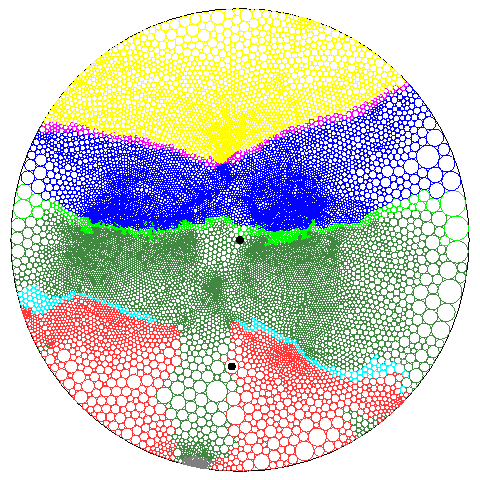 |
1Department of Mathematics,
Florida State University, Tallahassee, FL, U.S.A.
2Department of Radiology, University of
Minnesota, Minneapolis, MN, U.S.A.
3PET Imaging Center, VA Medical Center,
Minneapolis, MN, U.S.A.
4Department of Mathematics, University of
Tennessee, Knoxville, TN, U.S.A.
1,2,3,4Members of the International Neuroimaging
Consortium
|



|
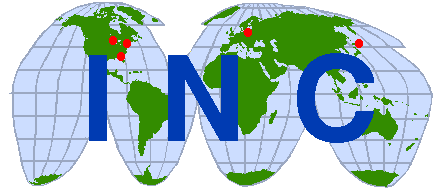
|
|
| |
| |
|
|
|
| |
|
|
|
|
| |
|
|
Abstract
- mapping the cerebellar cortex is essential for the description and
analysis of spatial and functional relationships within and between cortical
regions
- flat maps may assist in the analysis of
activated foci buried in interfolial fissures
We present cortical flat maps of the cerebellum
using our novel method of circle packing. These maps are conformal in character
as angular distortion is controlled. |
| |
| |
|
|
|
| |
|
|
|
|
| |
|
|
Our Approach to
Flat Mapping
- use math theory to create mathematically unique flat maps of the
brain
- it is impossible to flatten a curved surface in 3D space without
linear and areal distortion
- the Riemann Mapping Theorem (1854) says it is possible to preserve
conformal (angular) information
- our approach attempts to preserve the
conformal structure between the original cortical surface and
the flattened surface
|
| |
| |
|
|
|
| |
|
|
|
|
| |
|
|
Flat Mapping the
Cerebellum
- interested in describing activated cerebellar foci in functional
neuroimaging
- high resolution T1-weighted MRI volume obtained
[1]
- cerebellum extracted from volume and a topologically correct
triangulated surface representing the cerebellum produced
- functional data obtained from a target interception experiment (see
Figure 1)
- various lobes and fissures color coded for identification purposes
(see Figures 2 & 3)
|
| |
| |
|
|
|
| |
|
|
|
|
| |
|
|
- use circle packing [2] to create quasi-conformal
flat maps of the cerebellum in the conventional Euclidean plane, in the hyperbolic plane and on a sphere (see Figures 4,
5, 6 & 7)
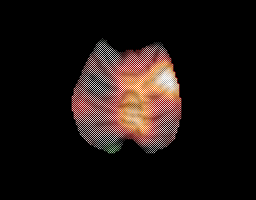
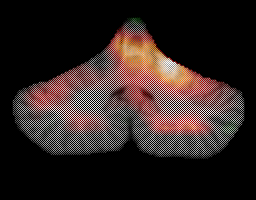
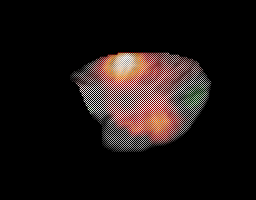 Figure 1: Axial (left), coronal
(middle) and sagittal (right) images showing functional activation of the
cerebellum from a target interception task.
Figure 1: Axial (left), coronal
(middle) and sagittal (right) images showing functional activation of the
cerebellum from a target interception task. |
| |
| |
|
|
|
| |
|
|
|
|
| |
|
|
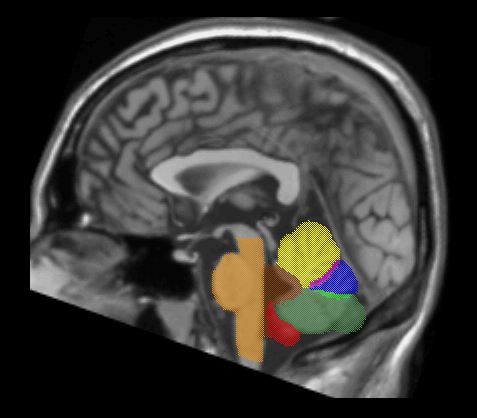
Figure 2: The human cerebellum is
colored according to the following cortical regions: forest green = lobulus
seminlunaris, lobulus semilunaris inferior, lobulus biventer; red = tonsils,
flocculus; yellow = lingula, lobulus centralis, lobulus quadrangularis; blue =
lobulus simplex, lobulus semilunaris superior; grey = white matter;
bright green = fissura prima; cyan = fissure secunda; magenta = fissura
horizontalis.
|
| |
| |
|
|
|
| |
|
|
|
|
| |
|
|
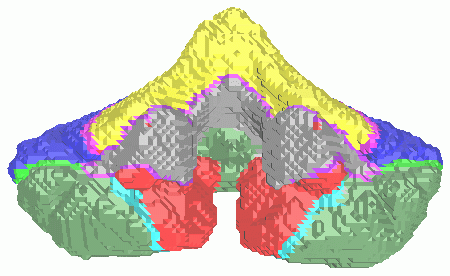
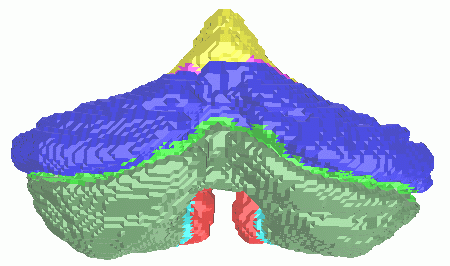
Figure 3: The surface representing
the cerebellum is exctracted from the MR images and rendered to show a view
from the front and back. Colors correspond to regions shown in
Figure 2 and purple corresponds to the boundary used
for flat maps.
|
| |
| |
|
|
|
| |
|
|
|
|
| |
|
|
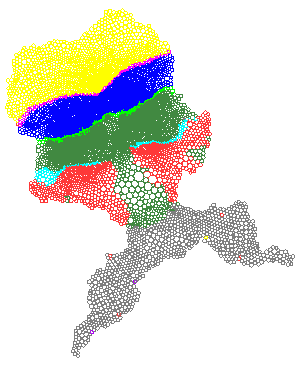
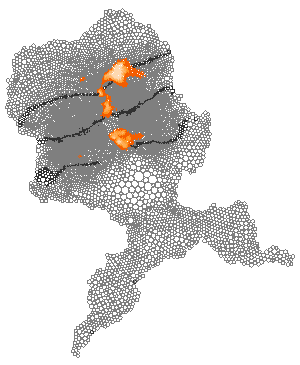
Figure 4: Flattened map of the
cerebellum (in the Euclidean plane). The colors in the left figure correspond
to anatomical regions shown in Figure 2. The colors in the
right figure correspond to regions of fucntional activation shown in
Figure 1.
|
| |
| |
|
|
|
| |
|
|
|
|
| |
|
|
 |
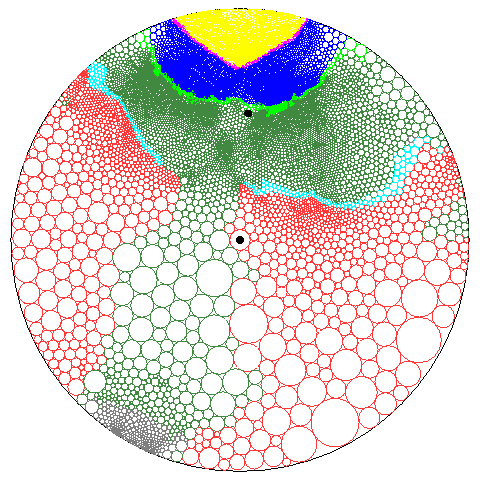 |
| Figure 5: Cerebellum mapped to a disk
(in the hyperbolic plane). The origin (map focus) is marked in black in the
center of the maps. The second map has been transformed to a different
map focus to display regions in the lower portion of the map. The black circle
located near the bottom of the first map is used as the map origin in the
second map. Similarly, the black circle located near the top of the second map
corresponds to the map focus of the first map.
|
|
| |
| |
|
|
|
| |
|
|
|
|
| |
|
|
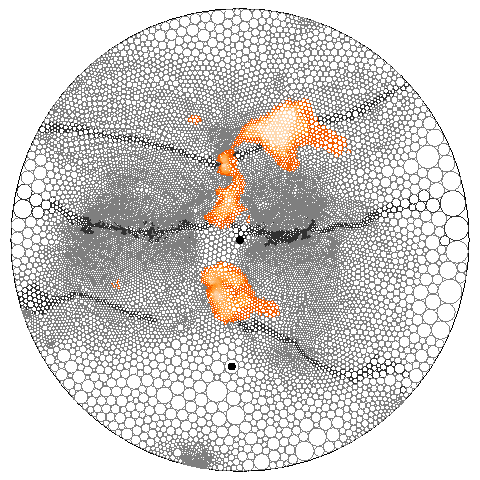 |
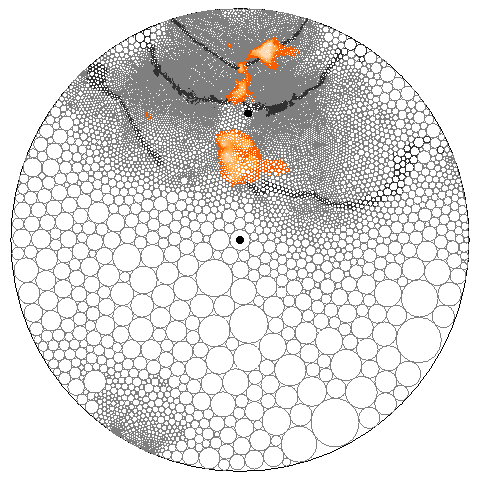 |
| Figure 6: Same maps as Figure
5 but regions of functional activation are shown from a
target interception task. The map foci are marked in black. Fissures are
indicated in dark grey and lobes are indicated in light grey.
|
|
| |
| |
|
|
|
| |
|
|
|
|
| |
|
|
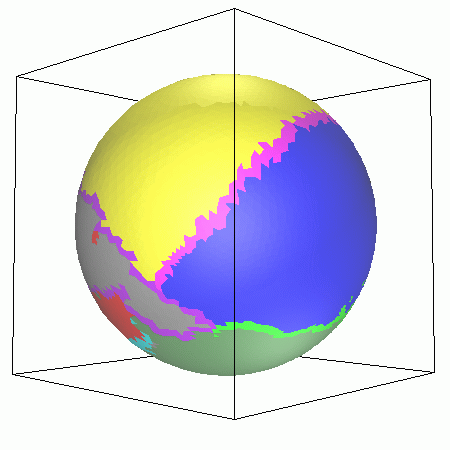 |
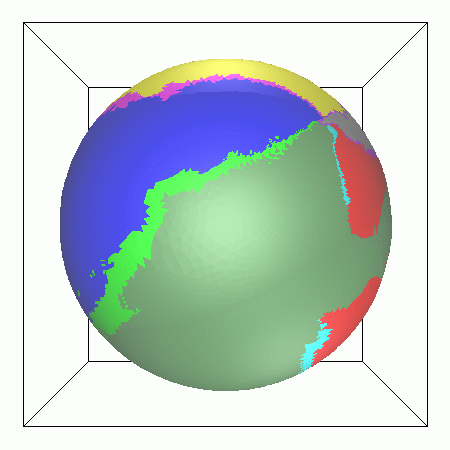 |
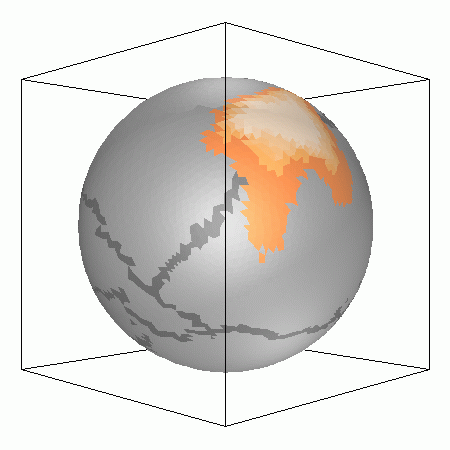 |
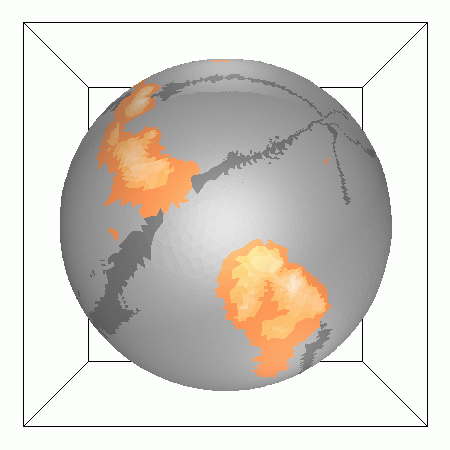 |
| Figure 7: Cerebellum mapped to a
sphere. Two different views are shown. Anatomical information is displayed on
the upper maps and functional information is displayed on the lower maps.
|
|
| |
| |
|
|
|
| |
|
|
|
|
| |
|
|
Advantages and
Benefits
- conformal mappings presereve angle proportion, are canonical and
hence mathematically unique
- easy to impose a coordinate system when given two anatomical
landmarks, which allows comparison of different maps
- easy to transform and change locations of map distortion
- no additional surface cuts are required
- clinical tool for analyzing anatomical and functional
differences
|
| |
| |
|
|
|
|
|
| |
|
|
|
|
| |
|
|
References
[1] Holmes, C. J., Hoge, R., Collins, L.,
Evans, A. C., Neuroimage, 1996, 3:S28.
[2] Dubejko, T. Stephenson, K., Experimental
Mathematics, 1995, 4:307-348. |
| |
| |
|
|
|



















